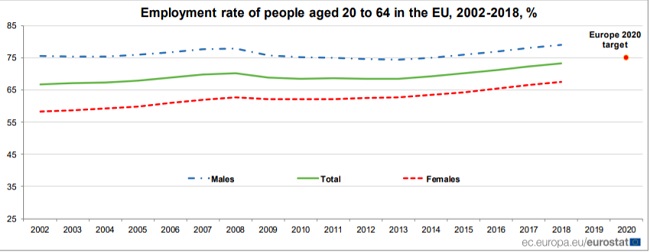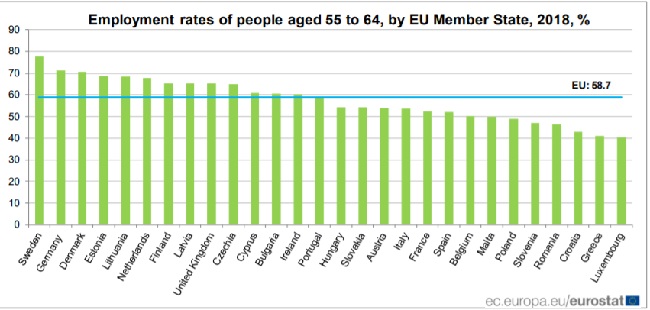Analytics, Employment, EU – Baltic States, Statistics
International Internet Magazine. Baltic States news & analytics
Wednesday, 24.04.2024, 20:50
Employment rate of people aged 20 to 64 in the EU reached a new peak at 73.2% in 2018
 Print version
Print versionThe upward trend in the employment rate is visible both for
men and women. The employment rate for men hit 79.0% in 2018, and has increased
steadily since 2013. As for women, their employment rate has continuously risen
since 2010 to reach 67.4% in 2018. Similarly, the employment rate of persons
aged 55 to 64 in the EU has grown steadily, from 38.4% in 2002 to 58.7% in
2018. The greater participation of older workers is also one of the objectives
of the Europe 2020 strategy on employment.
This information comes from the 2018 results of the European
Labour Force Survey. Further details are available in an article issued by
Eurostat, the statistical office of the European Union. This survey collects
data on employment and unemployment, as well as on a large range of other
variables related to the labour market, of which only a small selection is
shown in this News Release.

13 Member States already achieved their Europe 2020 employment target
Compared with 2017, the employment rate for those aged 20 to
64 increased in 2018 in all Member States without exception. It grew most
strongly in Cyprus (+3.1 percentage points, pp), Finland (+2.1 pp), Latvia,
Malta, Portugal and Slovenia (all +2.0 pp).
Employment rates above 75% were recorded in Sweden (82.6%),
Czechia and Germany (both 79.9%), Estonia (79.5%), the Netherlands (79.2%), the
United Kingdom (78.7%), Denmark (78.2%), Lithuania (77.8%), Latvia (76.8%),
Finland (76.3%), Austria (76.2%), Portugal and Slovenia (both 75.4%). Among
these Member States, Czechia, Germany, Estonia, Latvia, Lithuania, Portugal,
Slovenia and Sweden have already met or exceeded their 2020 national targets
for this indicator in 2018, as have Ireland, Croatia, Malta, Poland and
Slovakia.
On the other hand, the lowest employment rate was observed
in Greece (59.5%), although it grew over the year (+1.7 pp), followed by Italy
(63.0%, +0.7 pp), Croatia (65.2%, +1.6 pp) as well as Spain (67.0%, +1.5 pp).

Narrowest gender employment gap in Lithuania, widest in Malta
Employment rates of men and women continued however to vary
considerably in many Member States in 2018. The difference between the
employment rate of women and that of men aged 20 to 64 was lowest in Lithuania
(76.7% for women vs. 79.0% for men, or -2.3 pp), Finland (-3.7 pp), Latvia
(-4.2 pp) and Sweden (-4.3 pp). At the opposite end of the scale, the largest
difference between the employment rate of women and that of men was observed in
Malta (63.4% for women vs. 85.7% for men, or -22.3 pp). Big gaps were also
recorded in Greece (-21.0 pp) and Italy (-19.8 pp). At EU level, the difference
between the employment rate of women aged 20 to 64 (67.4%) and that of men aged
20 to 64 (79.0%) was -11.6 pp in 2018.
Employment rate of those aged 55 to 64 at its highest point in the EU
From 38.4% in 2002, the employment rate of people aged 55 to
64 in the EU has grown steadily to reach 58.7% in 2018. The growth was stronger
for women (from 29.1% in 2002 to 52.4% in 2018) than for men (48.2% in 2002 vs.
65.4% in 2018). As a consequence, the gap between the employment rate of women
and men aged 55 to 64 in the EU has been reduced, from a -19.1 pp difference in
2002 to a -13.0 pp difference in 2018.

Over 70% of people aged 55 to 64 have a job in Sweden, Germany and Denmark
In 2018, over half of the population aged 55 to 64 was in
employment in twenty-one EU Member States. The highest employment rate for this
age group was observed in Sweden (77.9%), ahead of Germany (71.4%), Denmark
(70.7%), Estonia (68.9%), Lithuania (68.5%) and the Netherlands (67.7%). On the
other hand, the lowest employment rates were registered in Luxembourg (40.5%), Greece
(41.1%) and Croatia (42.8%). Compared with 2017, the employment rate for those
aged 55 to 64 increased in 2018 in all EU Member States.









 «The Baltic Course» Is Sold and Stays in Business!
«The Baltic Course» Is Sold and Stays in Business!

